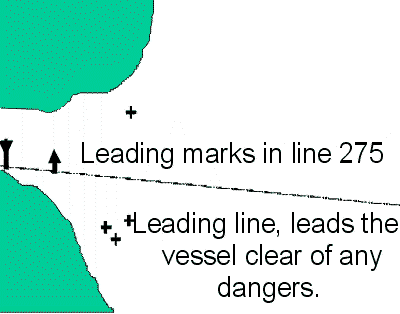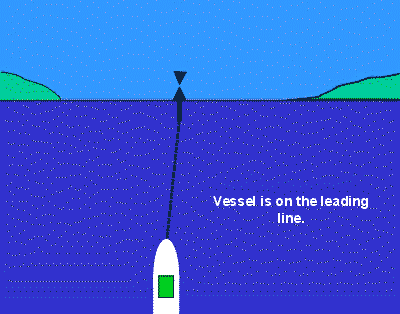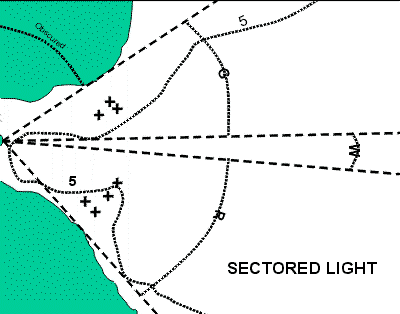Most harbours have some sort of leading lights or marks, the importance of these is that in a cross tide, they will enable you to follow the correct approach and not be swept off to one side.

The other concept that is important is to focus your attention on the important marks. When entering a harbour at night, there may be up to 30 lit marks all flashing away. If you try to keep track of all those lights you will become confused. The best approach is to identify the important lights, find them, and follow them in. The other lights on buoys and beacons can be used to give you a good idea of how far into the harbour you are.
|
|
|
|
|
The vessel must turn to starboard. |
The vessel is approaching from the correct direction. |
The vessel must turn to port. |
The bearings for any leading lines given on a chart, are always in true, because over time a magnetic bearing will change as variation changes.

A useful precaution with leading lines or beacons is to check that the bearing of the transit matches that from the chart. It is easy to convince yourself that you are following the correct line especially when you are tired and not notice that you have mistaken the lights.
Sectored lights
Instead of leading lights, some harbours use sectored lights. These are lights that show a different colour depending on where from where you see them.
The real value of these type of lights is that what you really need to know when you are entering a harbour is not, where you are exactly, but that where you are, is safe. Sectored lights will have a distinctly coloured light that indicates this perfectly.
The sectors are drawn on the chart with a dotted line and the colour of the light in that segment indicated by a letter. You will also find details of the angles of the segments in the almanac of Admiralty List of Lights; these angles are for the light when seen from seaward.

A common form of sectored light, is for the channel to be marked by a white light with a green sector to starboard and a red to port of the main channel. To use a sectored light in this combination; you place your vessel where the light can be seen, then move in to the white sector. Then, if the light changes colour to green, move back to the white sector again.
|
|
 |
|
|
Vessel must turn to starboard. |
Vessel is approaching in the correct sector. |
Vessel must turn to port. |
This type of light can make a passage that appears very tricky, quite simple, especially when any alterations of course, are indicated by a second sectored light.
Sectored lights will also be found out at sea. Some major lights have a coloured sector, either in the main light or sometimes with a secondary light. Look at the lighthouse at Start Point on Chart 2. There is a fixed red sector covering the Skerries Bank. The dotted lines indicate the angle of the sector through which the red light would be seen. The dotted arc where is written 'Arc of visibility of F.R. Light,' is not marking the distance that the light could be seen from the lighthouse, it is just printed at a convenient place. Start Point Lighthouse is obscured by Prawle Point, there is another sector line indicating this drawn in the bay outside Salcombe harbour.
Sailtrain.co.uk is free to use, but if you feel you would like to contribute to the running and development costs you can donate via Paypal:
Additional Resources:

